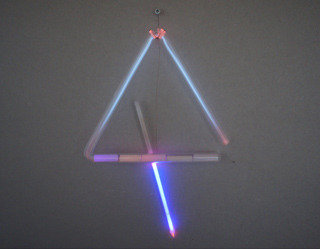8/9/2011
Navid Nuur
Plan B, Berlin
The exhibition title, CONDUCTORCONDUCTOR, is evocative in a way that is typical for this phenomenological magician, who chooses to work under the guise of 'visual artist.' 'In-betweenness' would be the most defining characteristic of Navid's organic, synaesthetic practice, with its formal echoes of Minimalism and Conceptual Art and a sensorial exoticism on the other.

The title of Navid Nuur's third solo exhibition with Plan B, CONDUCTORCONDUCTOR, is evocative in a way that is typical for this phenomenological magician, who chooses to work under the guise of 'visual artist.' There is obviously something very emphatic in the use of all-capitals in CONDUCTORCONDUCTOR, and something annoyingly manic, or at the very least impatient, in its repetition. It is as if Navid is trying to rid the term 'conductor' of its conventional meaning, by hinting at the loud repetition ad infinitum that will eventually turn all words into mere utterings. Indeed—one could argue it is analogous to the way Navid is compulsively unearthing all sorts of unspeakable truths from the mundane things he chooses to investigate in his art, by frantically repeating his inquisitive processes, over and over, through trial and error.
'In-betweenness' would be the most defining characteristic of Navid's organic, synaesthetic practice, with its formal echoes of Minimalism and Conceptual Art on the one hand, and a truly mindblowing sensorial exoticism on the other. The term applies to the position of the artist himself, too: he is always positioned in the middle, aiming to guide (or indeed, to conduct) his transformative processes to maximum impact. On the level of the works themselves, 'in-betweenness' points at the processual aspects that prevent them from becoming definite, static objects. A couple of years ago, Navid has coined the term 'interimodules' to describe his spatial work: they are things mediating between thoughts and their materialisation, negotiating the space they occupy, and their temporal presence. Always addressing the dynamics of change, these artworks choose to be alive, their soul illuminated by a swift artistic gesture. Like the raw clay that is slowly being fired from the inside rather than the outside, as one work in this exhibition will show, or the multilayered candy balls that are systematically but colorfully dismantled by the steady drip from various beverage bottles.
One of the works in CONDUCTORCONDUCTOR that in terms of its medium (video) seems somewhat atypical for Navid, nonetheless functions as a kind of nexus. In the video we see the artist in various outdoor locations in Berlin at night. He is moving extremely slowly, and very cautiously, as if performing a very deliberate, cartoonesque slow-motion version of himself. The performative act is executed in public non-places (streets, yards, back alleys) that happen to be equipped with light motion sensors—Navid is trying to move so slowly as not to be 'discovered' by the lights. When the lights happen to switch on, he freezes his position. In this simple, straighforward intervention in an everyday situation, Navid illustrates his position as an artist: he continuously finds himself moving between two states, a before-and-after, a cause-and-effect, a dark and light. It is he who is causing a change, a rupture, a sudden shift in the order of things, by trying to be slower than the light, in order to be faster than it.
What is interesting about Navid's work is that it combines a strictly rational logic (he follows so-called 'sets of rules') with an extremely powerful initial intuition: it is both religiously earnest and endearingly playful. In its focus on acute affective experience rather than intellectual rigor, it seems to pit itself against the factual dryness and cerebral referentiality that dominates much of today's art. Navid is advocating a new sensitivity, that is aimed at the stuff that surrounds us. A sensitivity that is ultimately reflecting on one of art's principle claims: how can we see the world anew, and imagine it otherwise.
The exhibition text was written by Xander Karskens, curator of contemporary art at De Hallen Haarlem, The Netherlands.
Navid Nuur (born 1976 in Tehran) lives and works in The Hague, The Netherlands. His work is currently on view in the group exhibition ILLUMInations, at the 54. Venice Biennale, Arsenale. Recent exhibitions include his solo show at Kunst Halle Sankt Gallen and group exhibitions at Stedelijk Museum, Amsterdam and MARTa Herford Museum, Herford.
Plan B
Heidestrasse 50- Berlin
Opening Hours: Tuesday–Saturday, 12–18 h



